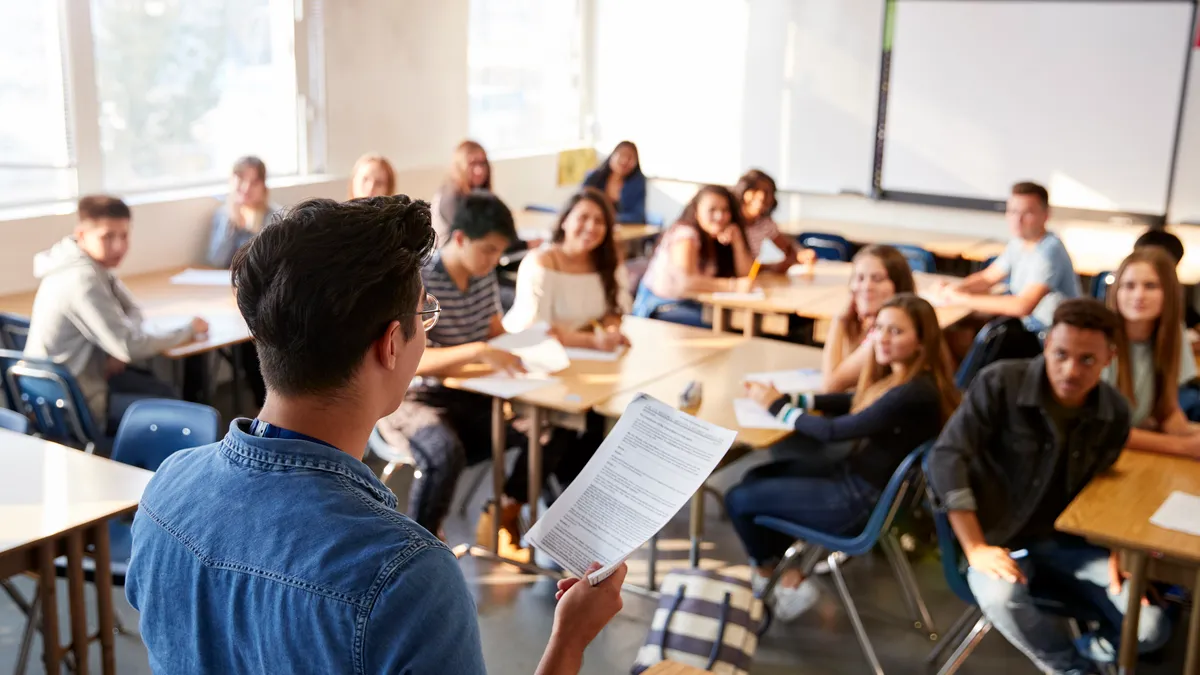Students with disabilities who attend public charter schools spend more of their school day learning alongside peers without disabilities compared to students with disabilities attending traditional public schools, according to research released Tuesday from The Center for Learner Equity, a nonprofit that supports inclusive school approaches.
However, an increase in the number of students educated in specialized charter schools that focus specifically on students with disabilities could eventually lead to less time in general education settings for students with disabilities, said the research, which also included analyses on discipline rates, enrollment, curriculum and college preparation.
Only about 30.3% of students with disabilities who attended a specialized charter school spent 80% or more of the day in general education settings during the 2020-21 school year. That's compared to 83.1% of special education students in charter schools overall and 67.5% of students with disabilities in traditional public schools, the CLE research found.
The difference in rates of inclusion in general education settings between charter schools and traditional public schools has been generally consistent since 2012, the report said.
"We find it promising that for the students with disabilities who are in public charter schools, that they're pretty significantly more likely to be educated in a general education classroom," said Jennifer Coco, CLE's senior director of strategy and impact. "What this data can't tell us is the quality of that instruction and their ability to still receive the appropriately individualized instruction that they need to be successful."
The report compliments a CLE study released in July on ways to expand proven practices and increase successful charter school opportunities for students with disabilities. That report focused on how charter school stakeholders could strengthen high-quality special education services for students attending public charters.
CLE's most recent data analyses aim to create awareness that could lead to more research and discussions about local, state and national policy and practices, Coco said.
Disproportionate discipline
For the recent research, CLE drew on data from the U.S. Department of Education's Civil Rights Data Collection, with the most recent data being from the 2020-21 school year.
The new CLE study acknowledges that the 2020-21 school year was unique, as schools continued remote teaching or attempted hybrid schedules because of the COVID-19 pandemic.
"We've got a really important, highly specified look at the experiences of kids with disabilities in this highly unusual school year," said Coco. It will be interesting to see if trends continue in the future, Coco added.
CLE's data analysis of CRDC statistics found the percentage of students enrolled in charter schools who qualify for special education services under the Individuals with Disabilities Education Act grew from 10.4% in 2012 to 11.5% in 2021. However, there is still a higher proportion of students with disabilities in traditional public schools — 14.1% in 2021.
When CLE researchers looked at CRDC discipline data from 2021, they found that, like in traditional public schools, charter schools showed declining rates of suspensions, arrests, restraint, seclusion and referrals to law enforcement since 2012. Although these rates were on a downward trend over that time period, CLE noted that the pandemic and 2020 racial injustice protests may have put pressure on schools to reduce the presence of law enforcement and unequal discipline practices.
But when CLE looked more closely at discipline rates of students with disabilities, they found both charter schools and traditional public schools had disproportionate rates compared to those of students without disabilities.
For instance, students with disabilities attending charter schools were secluded 2.11 times more than their peers without disabilities. In traditional public schools, students with disabilities were secluded 1.65 times more than their peers without disabilities.
"That's an example of one of those findings where we're calling on both sectors to say, 'No matter where students with disabilities are going to public school, they are disproportionately likely to experience disciplinary removal,'" Coco said.
High school experiences
CLE also took a close look at the experiences of high schoolers in charter schools. Here are some of the findings:
- The percentage of students with disabilities enrolled in Advanced Placement courses has increased over time, which aligns with an increase in AP participation among all students. In the 2020-21 school year, 4.4% of students with disabilities served under IDEA and attending charter schools took AP courses, an increase from 3.3% in 2018-19. Only 2.8% of students with disabilities attending traditional high schools in 2020-21 took AP classes. However, that figure is up from 2.5% in 2018-19.
- Charter schools had higher percentages of students with specific learning disabilities, other health impairments and emotional disturbance, compared to traditional public schools. But traditional public schools enrolled greater shares of students with autism, intellectual disabilities and other disabilities, including visual impairments and traumatic brain injuries.
- Participation of students with and without disabilities in dual enrollment courses in high school has increased overall, but traditional public schools had a higher portion of students with disabilities in dual enrollment compared to charter schools. Participation rates for students with disabilities in both charter schools and traditional public schools were well below the rates of students without disabilities.
Access to meaningful postsecondary education opportunities is severely more limited, which is "its own cause for alarm," Coco said. "We care very, very much about ensuring that kids with disabilities, students with disabilities have access to learning environments and opportunities where they can be successful and thrive and achieve the same postsecondary goals as any other student.”
Clarification: This story has been updated to better explain the timeframe for the discipline data that was analyzed.





















